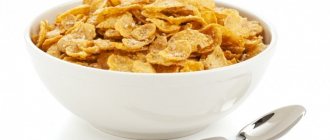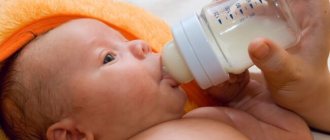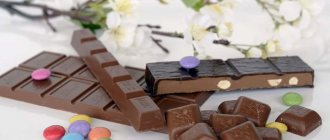Why do we need a milk bank?
Storage in a bottle or special container can be short-term or long-term. In the first case, you can make a supply for a short time so that the child does not experience hunger during the short absence of the mother. Sometimes, with the help of such a supply, fathers feed the baby at night, allowing the wife to sleep. A woman can also stop breastfeeding for a day to allow cracked nipples to heal.
How long breast milk is stored depends on the time of pumping after feeding
During long breaks, the nutritious product is frozen and then reheated. This is necessary if a woman:
- requires inpatient treatment;
- therapy with antibiotics and other medications with potent components is vital;
- you need to leave for a long time (for example, for a session).
Freezing is also used if there is milk, but the baby refuses to suckle. Or the baby is very ill and needs to be isolated in a hospital. And during the introduction of complementary foods, the product can be added to cereals to make the adaptation process easier.
In the first days of lactation, the mammary glands produce an excess amount of a valuable product. It’s worth freezing the excess for the future: suddenly for some reason the milk disappears, and the frozen product is five times richer in valuable elements than artificial formula.
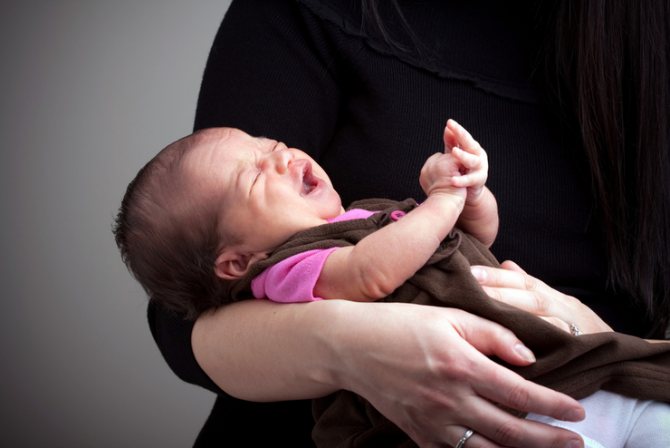
Storage in a bottle is required if the baby refuses to suckle.
Children's doctors, including the famous pediatrician Evgeny Komarovsky, believe that mother's milk from a “bank”, when properly stored, is almost as healthy as fresh milk. But in the first six months it is still better to maintain a natural feeding regimen and not take long breaks. This is good for both the baby and the mother herself, as it reduces the risk of mastitis and allows for faster recovery after childbirth.
How to calculate the required amount of milk?
If a baby suckles, he receives as much milk as he needs to be full. In the case of bottle feeding, a woman needs to be able to calculate the volume of liquid the baby needs. This is important so that the child does not remain hungry. The amount of milk required depends on the age and weight of the baby. You can calculate the volume of a single serving using a special formula.
The baby’s body weight in grams must be divided by 6. The resulting number is the daily volume of breast milk necessary for the normal development and growth of the baby. It should be divided by the number of feedings per day. On average, babies eat 5-8 times.
For example, a child's weight is 3600 grams. A baby needs 600 ml of mother's milk per day (3600:6=600). The baby eats 7 times a day. He needs to be given about 85 ml of food at a time. This calculation method cannot be called 100% accurate. We must understand that each child’s body is individual.
Some children have faster metabolic processes, so they need more food. Premature babies need increased nutrition. Gender also has a certain influence. For example, boys weighing 5-6 kg drink approximately 830 ml of breast milk per day, and girls - 775 ml.
The daily amount of milk for children with different body weights in the table:
| Child's weight in grams | Daily volume of mother's milk |
| 2500 | 390 |
| 3000 | 470 |
| 3500 | 550 |
| 4000 | 625 |
| 4500 | 705 |
| 5000 | 780 |
| 5500 | 860 |
| 6000 | 940 |
The approximate amount of milk per day and per feeding for children of different ages is in the table:
| Baby's age | Daily milk volume in ml | Size of a single serving, ml |
| 1-4 days | 350 | 60 |
| 4-7 days | 450 | 80 |
| 7-14 days | 20% of body weight | 90 |
| From two weeks to a month | 600 | 120 |
| 1-2 months | 800 | 150 |
| 3-4 months | 18% by weight | 200 |
| Up to six months | 1000 | 220 |
| Up to a year | 12% of body weight | 250 |
Expressing breast milk
Nursing mothers resort to pumping for various reasons:
- Lumps form on the chest caused by blockage of the mammary glands;
- a nursing mother has urgent matters outside the home and cannot feed the baby on schedule;
- excess milk that remains in the breast after feeding;
- maternal illness and hospitalization;
- to stimulate the breast if there is very little milk.
Before expressing, a woman is recommended to drink hot tea with milk or take a warm shower. It is also necessary to massage the breasts to stimulate the process. Several pumping options are possible:
- Using a breast pump. The device must be sterilized and dried before use. Breast pumps come in electric and manual versions. The choice is determined by financial capabilities and personal preferences. It is also recommended to pay attention to the ease of disassembly, the strength of the vacuum created, the list of components, the popularity of the brand, and ease of maintenance.
- Manual method. A simple method used by most breastfeeding mothers. First you need to thoroughly wash your hands with soap and prepare a sterilized container with a wide neck. Next, you will need to press your hand to your chest and, after massaging it, begin to stimulate the milk ducts with two fingers. If the amount of expressed milk is insufficient, the procedure must be repeated exactly with the second breast.
Having mastered the intricacies of the process, young mothers quickly learn to select the optimal rate of pumping so that milk can be stored in reserve and the baby will have enough during breastfeeding.
Tips for pumping
- If you use a breast pump, it must be thoroughly sterilized.
- Before the procedure, wash your chest and hands well with soap and dry them.
- The container for expressing must be sterile.
- After filling the container, mark the date and time on it.
- Do not fill the container to the brim if you plan to freeze the product, since milk tends to expand as it freezes.
Does the baby have enough milk?
Mothers often worry whether their baby has enough milk. It is not difficult to understand that the child is full and everything is fine, since in this case he is calm, happy, smiling, and chatting. But the feeling of hunger can be confused with colic, teething and other troubles that arise at different ages of the baby. Then you need to take other symptoms into account. You can increase the amount of milk given and see if the baby sucks it out. If he eats everything with appetite and is looking for more, then you need to gradually add the amount.
But the same question arises for breastfeeding mothers. If in this case it turns out that the baby is not eating enough, then you also need to express milk and feed the baby with it. There are several options here:
- supplement bottle feeding after breastfeeding;
- drink the baby from a glass;
- give milk using a spoon;
- make a special supplementary feeding system from a dropper.
Which one to choose is up to the mother to decide. Each of them has advantages and disadvantages. But you should not immediately switch to formula when the mother has enough milk. After all, malnutrition of a baby can occur due to the fact that he is simply unable to suck out the volume he needs. Or the child has certain health problems. And breast milk contains all the beneficial substances, and it is absolutely hypoallergenic (except in the case of lactose allergy).
Of course, situations vary, and the mother does not always have the opportunity to continue breastfeeding. But at the same time, she can save her milk and feed it to the baby from a bottle. Expressed breast milk retains all its beneficial properties; it is the best way to feed a child under 1 year of age. How to feed a baby with expressed milk, how much to give and whether it can be replaced with something else - these are questions that every mother asks and decides herself. Naturally, she should consult a doctor or lactation consultant. They will help you cope with these and many other problems.
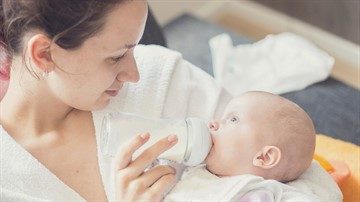
Mother's milk contains all the substances necessary for normal functioning, weight gain, growth and development of the baby.
It can be given to the baby by applying it to the breast or from a container with a pacifier. Feeding expressed milk from a bottle has its own characteristics, pros and cons.
Conditions for storing breast milk after expressing
You can express by hand or with a breast pump. It is important to wash your breasts first and prepare sterile containers. Stale milk must not be stored. It is unacceptable to mix it with formulas and baby food. Stores well at a temperature of +1-5 degrees, which corresponds to the refrigerator.
The product is always stored separately. If necessary, it is added to other baby food, only immediately before feeding. You need to stir it first. During downtime, the fattier part, the cream, tends to peel off.
What is the best way to store expressed milk?
— Storing breast milk is recommended in glass bottles, plastic containers or special bags (without bisphenol A).
“Containers containing bisphenol A, which has been found in some plastic containers (including baby bottles), should be avoided based on strong evidence found of its negative effects on the endocrine system. Caution should be exercised when using containers containing bisphenol S, an alternative to bisphenol A, as it may also have harmful effects."*
— The container in which the milk will be stored must be tightly closed. — It is advisable to write the freezing date on the container for expressed milk if long-term storage is expected.
How long can expressed milk be stored in the refrigerator, at room temperature and other conditions?
- At room temperature (from +16C to +27C) milk can be used within 4–8 hours. In the range from +27 C to +32 C, the permissible storage time is 4 hours.
- In a thermal bag (at a temperature of +15 C and below) it can be stored for up to 24 hours.
- In the refrigerator (from +4 C and below), the optimal shelf life of milk is 4 days, up to 8 days are allowed if cleanliness is maintained.
- In the freezer compartment of the refrigerator (at a temperature of -18 C and below), the optimal shelf life is up to 6 months, acceptable up to 12 months (according to The Academy of Breastfeeding Medicine, (ABM)).
- It is allowed to store expressed milk for up to one year in a separate freezer (from -17 C and below).
“Breast milk should not be stored in specialized medical containers, such as those used to collect urine or other body fluids, as there is insufficient evidence of their chemical safety and impact on the health of newborns; Only food-grade plastic containers should be used to store breast milk.”**
Of course, the longer the milk sits, the more beneficial components in it can be destroyed. It is better to use it within 3–6 months from the moment of freezing. This is another reason to sign containers.
The temperature at the back of the refrigerator or freezer is the most constant. This is the most secure place to store your milk containers.
Storing expressed milk: there are nuances!
- If you decide to freeze milk, you need to do it as soon as possible.
- Before placing milk in the freezer, you need to cool it in the refrigerator for 1-2 hours.
- You cannot add freshly expressed milk to already frozen milk; you should first cool the new portion.
- Milk that has already been thawed and heated cannot be added to frozen milk. Temperature changes will reduce the shelf life of the latter.
- Thawed and heated milk cannot be re-frozen; it must be discarded.
Glass bottles
The most environmentally friendly option is to use glass bottles. At the same time, you will also save on used bottles with caps and jars of baby food. All the disadvantages of glassware are more than compensated for by its positive properties:
- it washes off perfectly;
- withstands all types of sterilization, incl. steam treatment;
- used repeatedly;
- non-toxic when heated.
Adviсe:
- Do not risk freezing the product in a glass container. Glass will not withstand low temperatures in the freezer for long;
- glass may crack due to a sharp temperature change during heating;
- Store glass milk bottles on the refrigerator shelf. When frozen, the container may burst under the strong pressure of the increasing liquid.
Plastic bottles
You can also store breast milk in plastic bottles.
Bottles from Medela, Philips Avent, Canpol Babies are compatible with breast pumps, which allows you to express milk directly into the container. Bottles are available in different volumes - from 150 to 250 ml, with a scale for measuring the amount of expressed milk.
Special containers
Plastic containers for storing baby food have become widespread. They are not cheap (from 300 rubles and above), but they have advantages: the containers are durable, they can be used many times, they do not crack, you just need to wash them and pour boiling water over them. Manufacturers guarantee reliable tightness and safety, citing mainly the absence of besfinol A.
Attention! Bisphenol-A is a synthetic estrogen, synthesized in 1891 by the Russian chemist A. Dianin. It is used as an inexpensive hardener in the processing of plastics; it can be contained in baby bottles and plastic dishes. The substance has a negative effect on the brain, causing tumors of various origins, diabetes, obesity, and autism. Dangerous when heating or storing food or liquid for a long time.
In Russia, the production of baby bottles has begun by companies that have abandoned the use of this chemical compound. The “BPA-free” icon indicates the absence of this substance in the packaging.
Special packages
Plastic bags are sterile, easy to use, but expensive (average price: $10). Packages from Medela (from 800 rubles) and Avent (from 450 rubles) are popular among mothers. The package contains 25 bags of 150-180 ml:
- consist of two-layer polypropylene;
- the seams are additionally reinforced;
- The hole for pouring milk is wide;
- the base is stable;
- double protection clip;
- They are attached directly to the breast pump using adhesive tape.
Selection criteria and rules for caring for the bottle
Today there is a wide range of baby feeding bottles on sale. It is important for parents to be able to choose a container that is suitable for their child. Experts advise buying 3 bottles: two main ones and a spare one.
It is recommended to pay attention to the following points:
- volume. Determined by the age of the baby. A child under six months should buy bottles with a volume of 125-150 ml, and older children - 300-350 ml;
- form. Preference should be given to containers that taper in the middle. They are more convenient to hold while feeding the baby. They rarely slip out of your hands;
- material for making the container. It is better to give preference to glass. Plastic can release harmful components;
- pacifier. It is recommended to choose products made of silicone and shaped like a nipple with an areola. Experts advise having 2-3 nipples in stock. The holes should be medium in size;
- accessories. Some manufacturers offer models with a removable handle and measuring spoon. There are anti-colic options that prevent the baby from swallowing air during feeding.
Your baby's bottle should be cared for properly. The health of the baby depends on this.
Experts give the following recommendations:
- Wash the bottle and nipple before and after each use. You can use a brush for this. This device should be changed every two months. The use of dishwashing detergents is prohibited. It is permissible to use only warm soapy water;
- disinfect the container. To do this, you can use a special sterilizer. If it is not there, then you should boil the bottle and nipples for three minutes over low heat;
- To keep the container clean longer, it must be covered with a protective cap.
Storing breast milk
When faced with the need to store breast milk, new mothers will be surprised to discover that there are many different regulations. In the maternity hospital they announce some numbers, the pediatrician in the clinic names others, and more experienced friends may even have a separate opinion on this matter. In such a situation, it is easy to get confused.
It is worth considering that in a hospital or maternity hospital, doctors play it safe and make higher demands. They try to give expressed milk to a newborn right away and rarely store it for more than a few hours. At home the requirements are not so strict.
Thanks to protective antibodies, bacteria do not multiply in breast milk. Even if it is not stored in the refrigerator. This is confirmed by a number of studies conducted. Breast milk, expressed and left in a container for ten hours at a room temperature of about twenty degrees, contained no more bacteria than put in the refrigerator.
However, temperature, humidity and other indicators in residential premises vary. In order not to risk the baby’s health, it is better for young people to familiarize themselves with specific numbers, depending on the place and conditions of storage of breast milk.
Preserving colostrum
Use an unusual type of milk container - a medical syringe. It is ideally suited for preserving colostrum. It is possible to express and store the first milk not only after childbirth, but also during pregnancy.
Advice. Do this strictly with your doctor's permission! Excessive stimulation of the breast threatens premature birth.
While waiting for the baby, the following is done:
- colostrum is collected in a sterilized spoon, then in a syringe (5, 10 cc) and placed on the refrigerator shelf.
- the contents of 3-4 syringes collected per day are poured into a special sealed bag with a zipper, the storage start date is signed
- The package is sent to the freezer before delivery.
The table shows the shelf life of expressed milk and colostrum for a healthy baby:
| Storage temperature | Expressed milk | Colostrum |
| Room temperature 22°-25°C | 6 hours | 4 hours |
| Room temperature 18°-22°C | 10 o'clock | 12 o'clock |
| Room temperature 10°-12°C | 24 hours | 12 o'clock |
| Refrigerator +1° +3°С | 7 days | 24 hours |
| Refrigerator freezer -12° -18°С | 4-6 m. | 3m. |
| Deep freezing chamber -18° -24°С | up to a year | 3m. |
What affects shelf life
The product is poorly stored at high temperatures and lack of hygiene measures. Breast milk should not be boiled. It is contraindicated to re-freeze or try to reheat in a water bath, stove or microwave.
Transportation significantly reduces shelf life. If the bottle was taken for a walk and worn for several hours, upon returning home you need to get rid of the remains. Do not put it in the refrigerator, especially in the freezer.
We strongly do not recommend stocking up on breast milk if the nursing mother is unwell. You need to discuss this issue with your doctor. Along with food, the baby will receive pathogenic bacteria. Storing them in the refrigerator or freezer will not get rid of them.
At room temperature
If a nursing mother needs to leave home for several hours, then expressed milk can be stored without refrigeration. The baby’s lunch, even at room temperature, will not have time to spoil during this time. The beneficial substances in milk are completely preserved and there is no need to heat the bottle. Depending on the temperature in the living room, the permissible storage period will differ slightly:
- up to 15 degrees – 24 hours;
- up to 20 degrees – 10 hours;
- up to 25 degrees – 6 hours.
A nursing mother needs to take into account the above indicators when planning her absences from home. Additionally, a few more nuances should be taken into account. When storing breast milk in the room, the cap on the bottle should be tightly closed. It is better to place the container in a dark place out of reach of sunlight.
When going for a walk with your baby, you can take a special thermos for a baby bottle. This will increase the shelf life of milk, since the temperature will be optimal.
What else do you need to know when leaving milk at room temperature?
How long can breast milk be stored without a refrigerator was said above, now it’s worth talking about containers for its preservation.
Currently, the modern baby industry offers a huge range of containers for storing breast milk, made of plastic or glass. It doesn’t matter what the dishes are made of, the main thing is that the container can be cooled and heated, without compromising the composition of the product. The basic requirements that storage containers must meet are:
- sterility of the container;
- tightly closed lid;
- presence of a measuring scale on the container.
In such packaging, expressed milk will not be exposed to harmful bacteria and will be suitable for feeding for a long time. For convenience, it is recommended to sign the time when the milk was placed in it, this will make it easier to monitor its suitability, taking into account the temperature in the room.
In a refrigerator
If the mother is away from home for more than six hours, it is better to keep the expressed milk in the refrigerator. At temperatures from zero to five degrees, the shelf life increases to two days without loss of beneficial properties. It is not recommended to place the container on the refrigerator door or close to the edge. It is advisable to place it on a shelf as close to the back wall as possible.
Before feeding your baby, milk should be poured into an Avent bottle and warmed to room temperature. The nutritional quality will not be affected by this. Since milk can be stored for up to two days, mom can prepare five to seven servings in advance. After the specified period, it is unsuitable for use.
Refrigerator storage rules
There are several basic principles on how to store breast milk in the refrigerator, by following them you can be calm about the baby’s well-being.
- The milk container must be sterile, suitable for refrigeration, and the pumping time must be indicated on it. Thus, the product’s shelf life will be maximum.
- Containers should not be placed in the refrigerator doors; it is better to put them as far into the unit as possible, where temperature fluctuations are less noticeable.
- When you take out the milk for feeding, you should shake the container thoroughly so that the separated product is mixed again.
It is also worth knowing how to warm up breast milk from the refrigerator . There are several ways to do this:
- water bath: place the removed milk in a saucepan with cool water, put on fire and heat for a while, shaking the container until the contents reach the desired temperature;
- warming up with hot water: hold the container under running water and, shaking, warm it up to body temperature; you can check this by dripping milk on your wrist;
- special electrical device for heating.
Important: breast milk should not be heated by pouring it into a pan or in the microwave. Open fire or oven radiation can destroy the beneficial substances in the product and cause it to overheat.
In the freezer
Sometimes there is a need to stock up on breast milk for future use. This happens if a nursing mother leaves for a long time or undergoes long-term treatment in a hospital. In such situations, milk is stored in the freezer. It remains usable for three months. If a deep-freeze chamber was used, the period increases to six months.
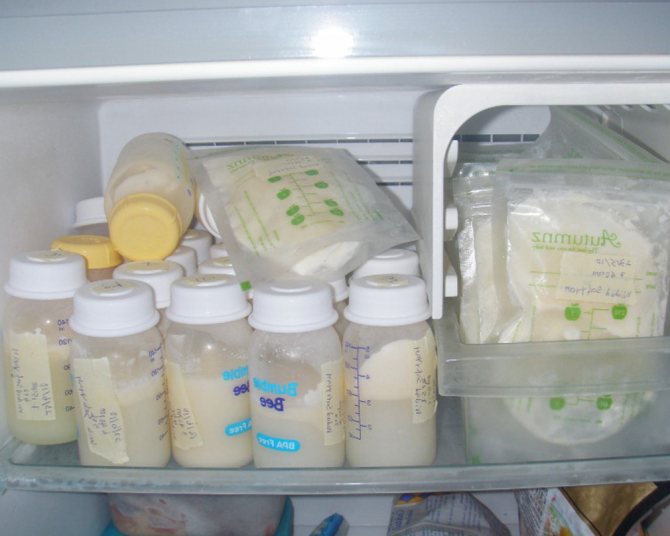
It is very important to choose a convenient container for storing breast milk in the freezer. Containers or bottles are not the best options as they take up a lot of space. For freezing, special sterile bags are usually used.
Some useful tips for young mothers:
- It is better to freeze containers with milk in a separate chamber, so as not to open the door again and prevent unwanted temperature changes;
- The dosage should be observed at the following rate: one package – one serving;
- Before freezing milk, it should be cooled first.
Storing breast milk on the go
If you need to transport breast milk from work to home or to nursery, use a cooler bag with ice packs 2 . For more information on pumping and storing breast milk on the go, see the article on pumping while traveling.
Video on the topic
Watch the video on how to properly express and store breast milk:
Thus, there are times when you have to bottle feed your baby with expressed breast milk. This feeding method has its positive and negative sides. A woman must understand how to pump correctly, in what quantity and how often to give the baby food. It is also important to know how to choose bottles with nipples for feeding your baby and how to properly care for them.
Breast milk is the best nutrition for a baby*. But breastfeeding is not possible for all women. For moms who are unable to breastfeed or maintain breastfeeding as long as they would like, quality infant formula is a healthy alternative.
The best thing is when the baby is in your arms, ideally in skin-to-skin contact: this position when bottle feeding, as with breastfeeding, creates close contact between mother and baby, helps them get closer and strengthens the emotional connection.
Feeding time is a time to be together and bond with your baby (and for dad too).
The first days of life are the period of adaptation of the baby to the world around him. And the first thing he looks for is protection and comfort. In the moments of being applied to the baby’s skin, the warmth of the mother’s body warms her, her smell and heartbeat, so familiar to him even before birth, soothe and comfort him. Gentle touches and calm breathing, a mother’s smile and soft voice, a formula warm like breast milk give the baby everything he needs - safety, warmth and nutrition.
Love and connection are the most important “ingredient” in any feeding process, and rich in vitamins and nutrients, infant formula will help you feel confident in your ability to care for your baby.
In theory, feeding your baby formula is just a few simple steps. But if you've never prepared a bottle of baby food or the time is three in the morning, everything seems complicated. Be patient to get into the rhythm.
For most mothers, bottle feeding becomes part of their baby's diet. And this does not depend on whether the bottle contains expressed breast milk or formula. The important thing is that sticking to exclusive breastfeeding may be difficult or impossible over time. Then the mother begins to supplement the baby with formula or switch him to completely artificial feeding.
Below are answers to parents' questions about how to properly and safely feed a baby from a bottle with formula.
How to prepare a bottle of formula milk
We invite you to go through the step-by-step process of preparing the first bottle for your baby.
- Hand hygiene: Wash your hands thoroughly with soap and warm water before handling bottles or feeding your baby. We also check the cleanliness of the table and measuring spoon.
- Sterilization: It is advisable to sterilize bottles and nipples in advance.
- Preparing water: boil baby bottled water and cool to a temperature of 40˚C, determine the required amount of water, then pour it into the bottle to the required mark - in accordance with the number of measuring spoons of dry formula according to the weight and age of your child.
- Let’s determine the volume of the mixture: on the can, in the “Feeding Table” block, it is indicated how many spoons are required for one feeding. The measuring spoon should be full and without a slide - we remove the excess on a special corner of the jar. Both day and night, it is better to look at the feeding chart (unless your doctor determines otherwise) so that you do not accidentally add too much or too little formula. Excessively diluted formula or excess formula may interfere with proper nutrition of the baby.
- Mixing according to the instructions: pour the required amount of the product without a slide into a bottle with prepared water. Next, close the bottle with a lid and roll it between your palms. Shaking the bottle can create a lot of foam.
- Checking the temperature of the finished food: drop a drop of the mixture on the inside of the wrist, where the skin is as sensitive as in the baby’s mouth. Immediately after preparing the mixture, tightly close the jar of baby food and feed the baby.
- We allow dad to give a bottle and be alone with the child - they also need communication and time to make friends. The reality is that many dads feel left out during breastfeeding, but this can be avoided by formula feeding. Show how to hold the baby and bottle, support your partner during the first feedings. This help will be useful for you too. An extra pair of hands when bottle feeding gives mom a little more precious time.
What water to use for preparing baby formula
Only boiled bottled baby water should go into the bottle. This is a great way to make sure the water you use is safe for your baby.
All baby water is registered by Rospotrebnadzor in accordance with SanPiN 2.1.4.1116-02. This water corresponds to the indicators of the highest category, is balanced in mineral composition and is characterized by low total mineralization in the range of 200-500 mg/l (the baby’s body is simply not able to absorb higher concentrations of minerals and salts).
Packaged water may look the same. But some manufacturers divide baby water into two categories - for drinking and for preparing formulas. Drinking water contains a higher concentration of minerals that are beneficial for the child’s body, but they can upset the balance of the nutritional mixture. Therefore, on the labels you can read about the different purposes of water: suitable for preparing baby food or for feeding infants and young children.
It makes no sense to make large reserves of baby water - water in open bottles becomes unusable after 24-48 hours, depending on the manufacturer. Tap or spring water is also not suitable for feeding infants. Such water may contain various impurities, bacteria and microbes that are dangerous for babies. Boiling will “free” water from harmful microorganisms, but not from impurities of heavy metals and chemicals.
How to use a measuring spoon correctly
A measuring spoon helps you accurately measure the amount of mixture and get the correct dosage. Fill the spoon full, but remove the heap. You don't need a kitchen knife for this - each jar with the mixture has a convenient wide corner for removing excess. And in economical 800 g jars, for example, in MAMAKO® Premium, the spoon is conveniently attached to the lid - so you don’t have to look for it in a large package before each feeding. Fingers and knives are not absolutely clean; there are always a lot of bacteria on them that can spoil the mixture and harm the baby’s health. The antibacterial attachment of the spoon and the corner of the jar protect the mixture and the baby from harmful bacteria from the external environment.
What temperature should the water and the finished mixture be?
Boiled water should be cooled to 40 °C. This temperature will preserve all the benefits of goat milk baby food. The easiest way to get water at the right temperature is to boil it in a kettle and let it cool for 20-30 minutes. A kettle for boiling water requires special care - it becomes covered with a mineral deposit, which is easily removed by boiling citric acid. This is a troublesome procedure because after cleaning it takes about 3-4 boils to remove traces of detergent. Create a rhythm for preparing the dishes - there will be no time for it at night or with a crying baby in your arms. The finished mixture should be warm: 37˚C. Before feeding, do not forget to check if the mixture is too hot by applying a couple of drops to your wrist. If it burns, you can hold the bottle under cold water for a while, after closing the nipple with a lid. If the mixture has cooled slightly, it is enough to warm it up under a warm stream of water.
Mixed feeding: breast or bottle first
The best feeding scheme is when the mother supplements the baby with formula after breast milk. If the baby is given a bottle first, he may begin to refuse the breast. This is explained by the fact that it is easier to suck through a nipple, and with natural feeding the baby has to “work” a lot to get mother’s milk.
How many baby bottles will you need for one day?
It all depends on what age you are bottle-fed, how much formula you give and how often the child eats. It's best to keep six to ten bottles on hand so you always have clean dishes. In addition, the more bottles, the less often they will have to be sterilized. Buy 125 ml bottles for your baby, and then move up to 150 ml and 240 ml as your baby's appetite and needs increase. Don’t rush to part with smaller bottles; they are great for supplementary feeding and water.
Why the bottle should not be held horizontally during feeding
Mom tilts the bottle so that the nipple is always filled with formula. The angle of inclination increases as the bottle is emptied - so it is important to be close to the baby, not leaving him alone during feeding even for a minute. If you do not tilt the bottle, the child will begin to swallow air. Air bubbles can cause regurgitation during or immediately after feeding. In addition, when air enters the baby’s stomach, he feels full faster, which means he eats less and will be hungry after a short period of time.
Which nipple to choose for a baby bottle
Many wide and narrow neck bottles already come with a set of baby nipples. Almost all of them are made of silicone. What shape of nipple - anatomical or round - and what size of the hole your baby will like can be understood by his reaction during feeding. If the mixture drips from the corners of your mouth, the flow may be too fast due to the large opening. If your baby sucks hard, the formula may drip too slowly. We recommend not to enlarge the opening of the nipple: it may tear, and microparticles of the product may enter the child’s body. Perhaps the hole is simply clogged, this happens sometimes. If necessary, nipples can be replaced and purchased separately from bottles.
Do baby bottles need to be sterilized?
Yes, to limit the spread of bacteria. Hard-to-reach areas of the bottle must be washed of the mixture (a brush and warm water is enough) before sterilizing. An ideal sterilizer for this purpose is ultrasonic, electric or steam for a microwave oven. It can sterilize all baby accessories - bottles, pacifiers, caps, brushes. Of course, you can replace the sterilizer by simply boiling it, but be careful that the water does not boil away, otherwise the bottles and nipples will be damaged and become dangerous.
Is it possible to use a microwave to heat the mixture?
Resist the temptation to microwave the mixture and save time. Microwave ovens heat liquids unevenly. Even if the bottle is not hot, the mixture can become quite hot and there is a risk of burning the baby. Additionally, heating in the microwave can cause the nutrients in formula to break down.
Is it possible to store the leftover formula after feeding?
If your child doesn't finish the formula, discard the leftovers. No need to heat it up and reuse it. This is unsafe for the baby. After a while, bacteria begin to multiply in the finished mixture. Mix a fresh portion of the formula every time your child is hungry.
How to prepare a bottle while traveling
If you will be away from home or on the road for several hours, you can take two bottles of warm boiled water in a thermal bag that retains heat. Before each feeding, you just need to pour the required amount of formula into the bottle (it is convenient to measure the portions in advance according to the number of feedings in the baby formula dispenser). If the water in the bottle has cooled down, just warm it up under warm water (this will take a little time). There should be enough bottles and nipples until the next opportunity to wash and sterilize them. Remember that a thermal bag is good for maintaining the temperature of boiled water, but it cannot be used to store the finished mixture - this is harmful to the baby’s health.
MAMAKO® fully supports breastfeeding, but since this is not always possible, we have shared how to bottle feed with love. In addition, preparing baby food will become a conscious and important task. Very little time will pass, and you will remember with emotion these precious minutes of tender age, and feeding time will become the beginning of a warm, close connection with your baby.
*The ideal food for an infant is mother's milk. WHO recommends exclusive breastfeeding for the first 6 months. MAMAKO® supports this recommendation. Before introducing new foods into your baby’s diet, consult a specialist.
How to freeze breast milk
Freezing is done in small portions - no more than 120 ml. This allows you to save valuable product and use small bags for supplementary feeding. Ideally, servings should be 60–80 ml.
Other points worth considering:
- freezing is suitable for milk that has been stored for no more than a day after expressing;
- maximum air removal from the tank is required so that valuable fatty acids are not destroyed;
- You cannot add milk to a container where a portion of the product is already frozen.
Before placing the container in the freezer, mark the date and time of collection. If the baby is very hungry, you can increase the serving size by mixing frozen milk and milk collected on the same day.
How to express properly?
Before the procedure, you need to wash your hands and prepare a container for collecting milk. Place your thumb and index finger on the edge of the areola. Apply light pressure to your chest. Squeeze and move your fingers in the direction from the areola to the nipple. For better milk release, you must first perform a massage and drink warm drinks.

Manual milk expression technique
How long does breast milk last?
If the expected break in feeding is short-lived, say, you need time to visit a doctor, a hairdresser, or just sleep, then the milk does not need to be frozen or even stored in the refrigerator. When the temperature in the house is not higher than 25 degrees, the nutritious product can retain its qualities for up to 4 hours. If the room temperature does not exceed 21 degrees, milk can “hold out” for up to 10 hours.
Refrigeration and freezing devices help preserve valuable liquid longer. Milk will not spoil if you hold it:
- in the refrigerator compartment, where the temperature is set at 0–4 degrees, for a week;
- in an unlocked freezer – two weeks;
- in a freezer with a tight door - four months.
If the equipment is equipped with a freezer created using no frost technology, then frozen milk can be stored for up to a year. But at the same time, you need to remove other products from the chamber and ensure a stable temperature regime of -20 degrees.
Containers with baby food are placed away from the doors and carefully checked before use. The spoilage of the product is indicated by a sour smell, a taste with sourness or bitterness, as well as strong separation with the formation of whey. But if the separation is not too contrasting, this is normal - lighter fats rise.
To restore consistency, you just need to shake the container.
To store milk not for too long in hot weather or during transportation, thermal bags are used. They also allow you to keep heated milk warm for some time - for this, instead of refrigerant, you put a bottle of boiling water in the bag.
Preparing to drink milk after freezing
When the time comes to feed your baby frozen milk, the first question that will arise is how to reheat it properly?
To begin, milk from the freezer needs to be placed in the main chamber of the refrigerator for about 12 hours.
It is very important - after the milk has been completely thawed, it is stored in the refrigerator for no more than 24 hours!
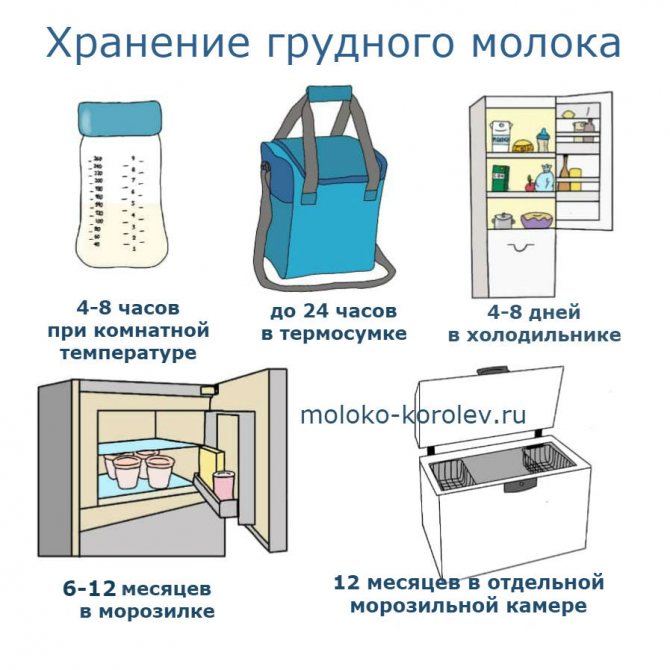
You cannot heat milk in a microwave oven or boiling water - this will negatively affect its properties! It is best to use a bottle warmer or simply place a container of milk in a mug of warm water. The optimal temperature for heated milk is no more than 37 degrees.
Before feeding, shake the container with milk a little, as it separates during storage. But don't shake too hard, otherwise the milk will foam and your baby will swallow air bubbles along with it!
Expressed milk that has been frozen may change color and smell. Mothers often notice that it smells like soap. This is normal. If all collection and storage rules are followed, this milk is absolutely safe for your child!
Attention: used milk, which may have received flora from the child’s mouth, must be used within an hour or thrown away!
How to properly defrost breast milk
The defrosting process must be carried out gradually. When you take frozen milk out of the freezer, you first need to put it in the refrigerator for several hours and then keep it at room temperature. After this, the container is placed under a stream of warm water, the temperature of which should not exceed thirty-five degrees.
Heating milk in a bottle using boiling water, a microwave oven or special heaters is not allowed.
In order not to be mistaken with the expiration date, there must be a sticker on the container with the date of pumping. After defrosting, breast milk loses some of its nutritional qualities. It is better to use it immediately.
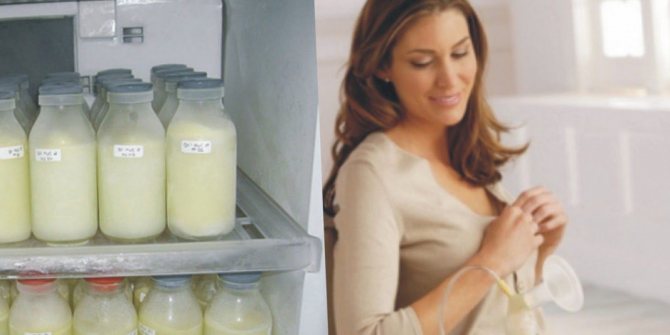
Thawed milk may change color and smell. This does not mean that the product has gone bad. Non-fatty acids manifest themselves in this way during the freezing process. However, if there is a strong sour smell, milk should never be given to a child. This liquid should be poured out. Re-freezing breast milk is also not allowed. It should be consumed as intended within 24 hours or poured down the sink.
Storing breast milk seems like a complicated process at first glance. Despite the abundance of nuances, following simple rules and recommendations will help extend the shelf life of the most important product for newborns.
How to reheat
If the milk has just been standing in the cold, it is heated to 36 degrees under a stream of hot water, in a water bath or in a special heater. A thermometer is used to determine the degree of heating.
You shouldn’t just drip it on your wrist; you could make a mistake and give your baby too hot milk.
Frozen milk requires initial thawing. If you have an extra half hour, you can do this without using hot water - in room conditions. After this, they resort to heating in a water bath or in a special device. This should not be done in a microwave oven so as not to destroy useful elements. You should also not store thawed milk for longer than 12 hours or refreeze uneaten portions.
The duration of storage of breast milk depends on the conditions that were created for it, so you need to figure out how to preserve the benefits and nutritional value after expressing. With the right approach, you can freeze a valuable product for a year, but still, long breaks in breastfeeding are undesirable. Fresh milk is healthier than milk that has been standing or frozen.
How to take him for a walk
Another difficult task awaits young mothers - how to store expressed milk while walking. This is where special thermoses for bottles and thermal bags will come to the rescue. Thanks to them, you can take up to several servings of valuable nutrition with you on a long walk.
And yet, according to many doctors, including Dr. Komarovsky, if possible, try to breastfeed your baby rather than express milk. This can be done even while walking.
To ensure that no one interferes with feeding, there are special feeding aprons, blankets and shawls. Many large supermarkets have a special nursery where you can feed and swaddle your baby.
Feeding scheme and rules
Feeding with expressed milk from a bottle is carried out according to the same schedule as in the case of putting the baby to the breast. Pediatricians advise feeding newborns on demand. On average, babies need food every 2-3 hours.

It is important to follow the rules for bottle feeding your baby:
- the container into which the liquid is poured and the nipple must be clean;
- Milk should be offered to the baby fresh and of high quality. Do not give a product that has been stored in inappropriate conditions.
Experts recommend following the following bottle feeding algorithm:
- warm breast milk. The optimal liquid temperature is +34-36 degrees;
- take the baby in your arms and give him a reclining position;
- Offer your baby a bottle with a nipple. The baby should be fed at intervals of 2-3 seconds;
- hold the baby upright for about 3-5 minutes. This is necessary so that the air swallowed during feeding comes out and bloating does not occur.
What not to do
To preserve all the beneficial substances during storage, you should forget about:
- repeated freezing - then access to harmful bacteria and microbes is opened;
- heating in the microwave, over an open fire or sterilization - this will kill all the vitamins and enzymes necessary for the child;
- reheating - just like with defrosting, there will be nothing useful left in the milk after re-processing. Everything given to the baby must be fresh.
Proper storage of expressed milk will help the mother maintain an active lifestyle despite continuing breastfeeding. After all, a well-fed and happy child is the key to a mother’s good mood, and the baby will be ready for any walk or trip, and in cases where the mother is not at home, she will be able to continue proper and healthy nutrition.
Testing for suitability: how to determine whether expressed milk has spoiled during storage?
Signs of unsuitability of breast milk are practically no different from signs of souring of cow, goat or any other milk. We offer several ways to determine whether your baby can be fed this milk or whether it’s time for him to go to waste:
- Smell and taste. A rotten “aroma” and sour taste indicate that in mastering the science of how to store expressed breast milk, you missed some important point and, as a result, violated the technology. Such liquid is definitely sent for disposal.
Clarification: a specific “soapy” smell and taste are normal and do not harm the baby, moreover, most children do not react at all to such minor changes in taste.
- Consistency. A sign that defrosted milk is spoiled are lumps or lumps that do not dissolve when shaken. It’s definitely not worth feeding such a product to your baby.
- Warming up. The most reliable way to check is warming up. Pour some milk into a tablespoon and hold it over a lit burner. The spoiled liquid, under the influence of temperature, will disintegrate into curds and whey. You can easily make homemade cottage cheese out of it for your child, but you cannot offer him to drink such milk.
Sometimes you can come across a recommendation to pay attention to the color of the milk. In our opinion, this indicator is not entirely informative, since the shade of a product can change even throughout the day depending on a woman’s menu, which means it is impossible to compare the shade of a thawed or taken from the refrigerator product with the original one.
Signs of spoiled milk
Before you start feeding your baby with expressed breast milk, you should make sure that it has not spoiled.
If the fat rises up, separating from the milk, then this is considered normal. It is also normal if it has a bluish color, watery consistency or a “soapy” smell.
A sign of spoilage is an unpleasant, sharp, sour smell. This product should not be offered to a child.
Why does milk smell strange after storage?
Refrigerated or thawed breast milk may smell different from fresh breast milk. This is due to the action of lipase, an enzyme that breaks down fats into fatty acids, preventing the growth of dangerous bacteria.
Some mothers note that after storage their milk has a rancid or soapy smell. But if you followed all the recommendations for safe storage given in this article, such milk is absolutely safe.
Drinks prohibited while breastfeeding
For many women, the most difficult thing during breastfeeding is the forced refusal of coffee. We hasten to please you: you can drink coffee . Just not very strong and not very often, preferably one cup in the morning. Then the caffeine, which can enter the baby’s body along with milk, will “dissipate” in the evening, and he will calmly go to bed at night, without giving everyone a home concert.
But what you should categorically refuse is carbonated drinks . And it’s not so much about carbon dioxide, but about dyes, flavors, preservatives, sugars and other additives that are harmful even for a healthy adult, not to mention a nursing mother and infant.
That’s why Fante, Sprite, and especially Coca-Cola and their analogues are a firm “no,” just like alcohol, even high-quality and weak ones. All other drinks can and should be drunk, with only one caution - so that they do not cause allergies in the baby.
10, total, today
( 193 votes, average: 4.56 out of 5)
How to prepare your child for vaccination
Hallux valgus in a child: causes, diagnosis, treatment
Related Posts
Recommendations for feeding expressed breast milk
When stored, breast milk usually separates into layers and the fats (cream) it contains rise to the top. Shake the bottle gently to mix the layers before giving it to your baby. Violent stirring and shaking may destroy some of the nutritional and protective components of breast milk 5 .
When a baby feeds expressed breast milk from a cup or bottle, bacteria from the baby's mouth naturally gets into the milk. Therefore, it is best to pour out all unfinished milk one to two hours after the first feeding. To waste as little expressed milk as possible, it is best to store it in small portions and use only as much as needed for one feeding /
Tips from Maria Bezhko
No matter how much we would like to always be with the baby, sometimes situations arise when the child has to be given supplementary feeding, with pre-prepared breast milk.
Most often these are the following situations:
- The need to urgently leave the baby for quite a long time. This situation may arise due to an urgent return to work, a long trip, or a business trip.
- Due to breast problems. Painful cracks may appear on the mammary glands, and the child may bite through the breast. With such troubles, breastfeeding becomes problematic. A possible cause is improper attachment of the baby to the breast.
- Because of the child's health. A premature baby, or a child, due to physiological reasons, who is unable to breastfeed. Feeding such a child with expressed milk may be a temporary measure.


